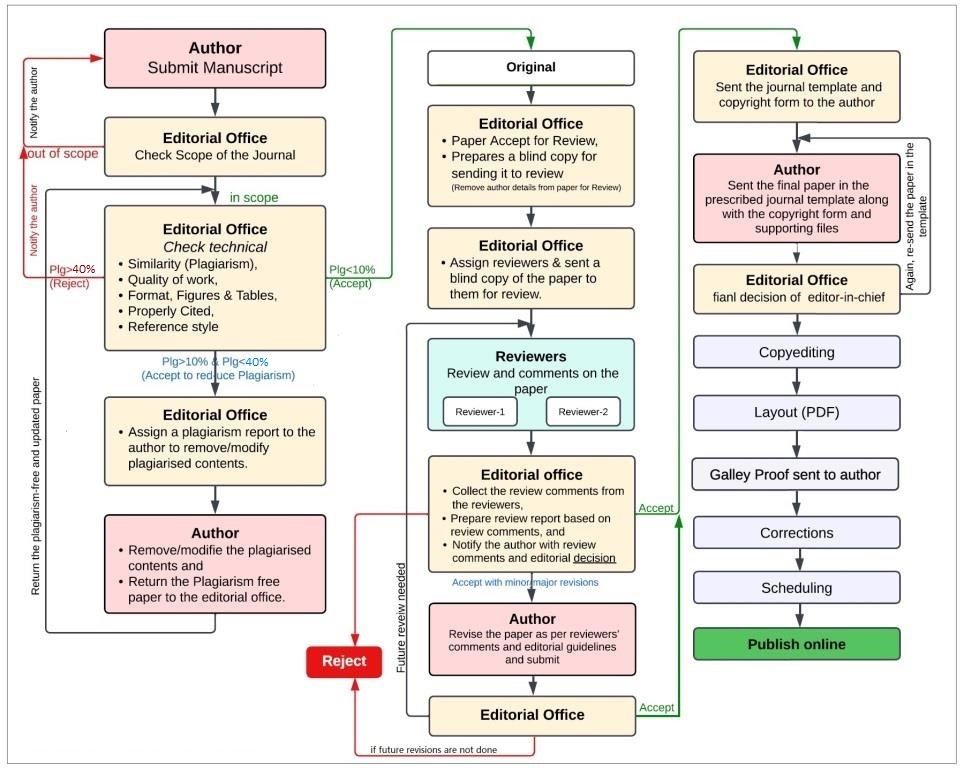Peer Review Process
This journal follows a double-blind peer review process, and all papers will be assigned to at least two qualified reviewers through the steps described below. Decisions will be made as rapidly as possible, and the journal strives to return reviewers’ comments to authors after 5 weeks because the review process may take 4 to 15 weeks, depending on the number of cycles of review required, before the paper is finally accepted.
The following steps are followed during the entire review process:
- Firstly, the scope of work of the submitted paper is checked by the editorial team based on the scope of the journal, if the scope of the paper is within the scope of the journal, then it is forwarded to the next stage; otherwise, it is rejected.
- The Similarity check (Plagiarism), quality, layout, format (table and figure, reference style, properly cited),and other ethical compliances of the paper are checked by the editorial team. If the quality, format is correct, and plagiarism is less than 10%, then it is sent to the next step. If the quality and format are not correct and plagiarism is not less than 10%, then it is reverted to the author for correction along with a plagiarism report; otherwise, it is rejected.
- If the paper selected by the editorial board, the paper shall be subjected to a fair and unbiased double-blind peer review by at least two referees on the basis of its originality, novelty, clarity, completeness, relevance, significance, presentation language, and research contribution.
- Reviewer's reports are collected by the Editorial Office of the Journal. The Editor-in-chief/Associated Editor is either rejecting the paper - or requesting a revision from the authors based on the reviewers’ comments (minor, major revision requests or reject recommendation) or Accept as it is .
- Authors return their revised manuscripts to the editorial office. The Editor-in-chief/Associate Editor is taking a decision—accept, the second round of revision, or reject—and communicating the decision to the authors. If an additional revision is recommended by the reviewers, the papers may undergo multiple cycles of review before finally being accepted.
- Authors are allowed to perform two rounds of revisions. If reviewers are not convinced by the arguments of the authors after the second round of revisions – the manuscript is automatically rejected.
- The final decision is communicated to the corresponding author(s). Acceptance or rejection notification of a paper is based on the review remarks by the referees and the decision of the editorial board.
- After receiving the final paper and copyrightform then undergoes paper formatting, technical editing, language editing, proofreading and finally is published.
- In cases where only minor or major revisions are recommended, editor will contact the corresponding author and will offer to revise the manuscript. Additional reviewers or further review reports may be requested in case of conflicting review reports.
- Revised versions of manuscripts may or may not be sent to reviewers. By default, reviewers who request major revisions or recommend rejection will be sent the revised manuscript. All reviewers can access the most recent version of the manuscript via the reviewer dashboard.
- A maximum of two rounds of major revision per manuscript is normally provided.
- Acceptance decisions on manuscripts can be taken by the Editor in Chief after peer-review once a minimum of two review reports have been received.
- The Editor in Chief can select from the following options: Accept in current form, accept with minor revisions, reject and decline resubmission, or reject but encourage resubmission.
- Authors may appeal a rejection or any other decision taken by the publisher by sending an email to ijsrnsc@gmail.com. Author appeals will be investigated, and immediate confirmation of the reception of the appeal will be given to the author within three working days.
Final Proof of the Paper: One set of page proofs (as PDF files) will be sent by e-mail to the corresponding author or a link will be provided in the e-mail so that the authors can download the files themselves. These PDF proofs can be annotated; for this you need to download Adobe Reader version 7 (or higher) available free from http://get.adobe.com/reader. If authors do not wish to use the PDF annotations function, they may list the corrections and return them to IJSRNSC in an e-mail. Please list corrections quoting line number. If, for any reason, this is not possible, then mark the corrections and any other comments on a printout of the proof and then scan the pages having corrections and e-mail them back, within 05 days. Please use this proof only for checking the typesetting, editing, completeness and correctness of the text, tables and figures. Significant changes to the paper that has been accepted for publication will not be considered at this stage without prior permission. It is important to ensure that all corrections are sent back to us in one communication: please check carefully before replying, as inclusion of any subsequent corrections cannot be guaranteed. Proofreading is solely authors’ responsibility. Note that IJSRNSC will proceed with the publication of paper, if no response is received within 07 days.
The main functions of the peer review process are to help maintain standards and ensure that the reporting of research work is as truthful and accurate as possible.

You do not have rights to view the full text article.
Please contact administration for subscription to Journal or individual article.
Mail us at ijsrnsc@gmail.com or view contact page for more details.
